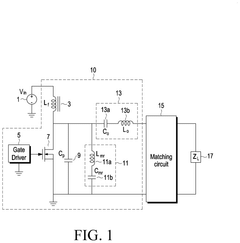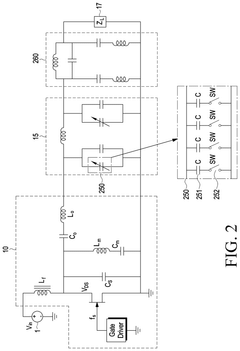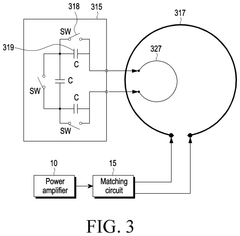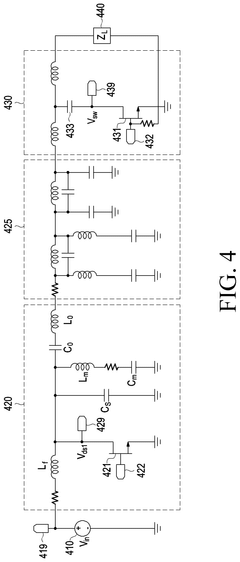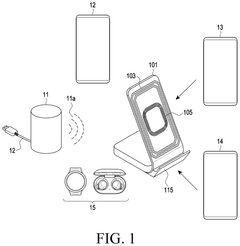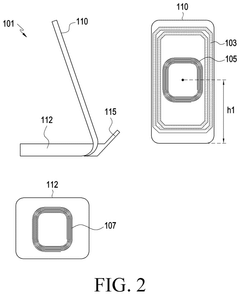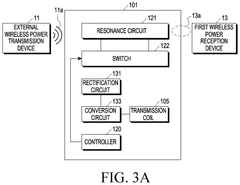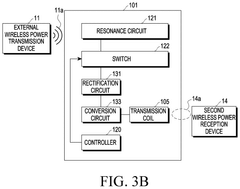Blade Battery's Role in Wireless Power Transmission Prospects
AUG 8, 20259 MIN READ
Generate Your Research Report Instantly with AI Agent
Patsnap Eureka helps you evaluate technical feasibility & market potential.
Blade Battery Evolution
The evolution of Blade Battery technology represents a significant milestone in the development of energy storage solutions, particularly in the context of wireless power transmission. Initially conceived as a safer alternative to traditional lithium-ion batteries, Blade Batteries have undergone rapid advancements since their introduction.
In the early stages, Blade Batteries were primarily focused on addressing safety concerns in electric vehicles. The unique design, featuring long, thin cells arranged in a blade-like configuration, allowed for improved heat dissipation and reduced risk of thermal runaway. This innovation quickly gained traction in the automotive industry, prompting further research and development.
As the technology matured, researchers began exploring its potential applications beyond electric vehicles. The high energy density and stable performance characteristics of Blade Batteries made them an attractive option for various energy storage applications, including grid-scale systems and portable electronics.
The integration of Blade Battery technology with wireless power transmission systems marks a pivotal point in its evolution. This convergence addresses two critical challenges in modern energy systems: efficient energy storage and convenient power delivery. The flat, compact design of Blade Batteries aligns well with the form factor requirements of wireless charging systems, enabling seamless integration into various devices and infrastructures.
Recent advancements have focused on optimizing the battery chemistry and cell structure to enhance power transfer efficiency in wireless charging scenarios. Researchers have made significant progress in reducing internal resistance and improving charge acceptance rates, crucial factors for effective wireless power transmission.
The evolution of Blade Batteries has also seen improvements in manufacturing processes, leading to increased production efficiency and reduced costs. This has been instrumental in broadening the technology's applicability across different market segments and accelerating its adoption in wireless power transmission systems.
Looking ahead, the trajectory of Blade Battery evolution is closely tied to advancements in wireless power transmission technologies. Ongoing research is exploring novel materials and cell architectures that could further enhance the synergy between these two technologies. The goal is to develop integrated systems that offer high-capacity energy storage with the convenience of wireless charging, potentially revolutionizing how we power our devices and vehicles in the future.
In the early stages, Blade Batteries were primarily focused on addressing safety concerns in electric vehicles. The unique design, featuring long, thin cells arranged in a blade-like configuration, allowed for improved heat dissipation and reduced risk of thermal runaway. This innovation quickly gained traction in the automotive industry, prompting further research and development.
As the technology matured, researchers began exploring its potential applications beyond electric vehicles. The high energy density and stable performance characteristics of Blade Batteries made them an attractive option for various energy storage applications, including grid-scale systems and portable electronics.
The integration of Blade Battery technology with wireless power transmission systems marks a pivotal point in its evolution. This convergence addresses two critical challenges in modern energy systems: efficient energy storage and convenient power delivery. The flat, compact design of Blade Batteries aligns well with the form factor requirements of wireless charging systems, enabling seamless integration into various devices and infrastructures.
Recent advancements have focused on optimizing the battery chemistry and cell structure to enhance power transfer efficiency in wireless charging scenarios. Researchers have made significant progress in reducing internal resistance and improving charge acceptance rates, crucial factors for effective wireless power transmission.
The evolution of Blade Batteries has also seen improvements in manufacturing processes, leading to increased production efficiency and reduced costs. This has been instrumental in broadening the technology's applicability across different market segments and accelerating its adoption in wireless power transmission systems.
Looking ahead, the trajectory of Blade Battery evolution is closely tied to advancements in wireless power transmission technologies. Ongoing research is exploring novel materials and cell architectures that could further enhance the synergy between these two technologies. The goal is to develop integrated systems that offer high-capacity energy storage with the convenience of wireless charging, potentially revolutionizing how we power our devices and vehicles in the future.
Wireless Power Market
The wireless power market has experienced significant growth in recent years, driven by the increasing demand for convenient and efficient charging solutions across various industries. This market encompasses a wide range of applications, including consumer electronics, automotive, healthcare, and industrial sectors. The global wireless power transmission market is projected to reach substantial value in the coming years, with a compound annual growth rate (CAGR) that reflects the rapid adoption of this technology.
Consumer electronics, particularly smartphones and wearable devices, have been the primary drivers of wireless power adoption. The convenience of placing a device on a charging pad without the need for cables has resonated strongly with consumers, leading to widespread integration of wireless charging capabilities in flagship devices from major manufacturers. This trend has expanded to other consumer products such as laptops, tablets, and smart home devices, further fueling market growth.
In the automotive sector, wireless charging for electric vehicles (EVs) is gaining traction as a potential game-changer for the industry. The ability to charge EVs without physical connections offers advantages in terms of convenience, safety, and durability. Several automakers and technology companies are investing in the development of wireless charging systems for EVs, which could significantly impact the future of transportation infrastructure.
The healthcare industry has also recognized the potential of wireless power transmission, particularly in medical implants and wearable medical devices. Wireless charging eliminates the need for invasive procedures to replace batteries in implanted devices, improving patient comfort and reducing infection risks. This application is expected to see substantial growth as the technology matures and regulatory approvals are obtained.
Industrial applications of wireless power are emerging in areas such as factory automation, where wireless charging can enhance the flexibility and efficiency of robotic systems and other equipment. The ability to charge devices in harsh or hazardous environments without physical connections offers significant advantages in terms of safety and operational continuity.
Despite the promising outlook, the wireless power market faces challenges such as limited power transmission range, efficiency concerns, and the need for standardization across different technologies and devices. However, ongoing research and development efforts are addressing these issues, with advancements in resonant charging and beam-forming technologies showing potential for overcoming current limitations.
As the market continues to evolve, the role of innovative battery technologies like the Blade Battery in wireless power transmission becomes increasingly relevant. The integration of high-performance, safe, and efficient battery systems with wireless charging capabilities could unlock new possibilities for extended device operation and enhanced user experiences across various applications.
Consumer electronics, particularly smartphones and wearable devices, have been the primary drivers of wireless power adoption. The convenience of placing a device on a charging pad without the need for cables has resonated strongly with consumers, leading to widespread integration of wireless charging capabilities in flagship devices from major manufacturers. This trend has expanded to other consumer products such as laptops, tablets, and smart home devices, further fueling market growth.
In the automotive sector, wireless charging for electric vehicles (EVs) is gaining traction as a potential game-changer for the industry. The ability to charge EVs without physical connections offers advantages in terms of convenience, safety, and durability. Several automakers and technology companies are investing in the development of wireless charging systems for EVs, which could significantly impact the future of transportation infrastructure.
The healthcare industry has also recognized the potential of wireless power transmission, particularly in medical implants and wearable medical devices. Wireless charging eliminates the need for invasive procedures to replace batteries in implanted devices, improving patient comfort and reducing infection risks. This application is expected to see substantial growth as the technology matures and regulatory approvals are obtained.
Industrial applications of wireless power are emerging in areas such as factory automation, where wireless charging can enhance the flexibility and efficiency of robotic systems and other equipment. The ability to charge devices in harsh or hazardous environments without physical connections offers significant advantages in terms of safety and operational continuity.
Despite the promising outlook, the wireless power market faces challenges such as limited power transmission range, efficiency concerns, and the need for standardization across different technologies and devices. However, ongoing research and development efforts are addressing these issues, with advancements in resonant charging and beam-forming technologies showing potential for overcoming current limitations.
As the market continues to evolve, the role of innovative battery technologies like the Blade Battery in wireless power transmission becomes increasingly relevant. The integration of high-performance, safe, and efficient battery systems with wireless charging capabilities could unlock new possibilities for extended device operation and enhanced user experiences across various applications.
Technical Challenges
The integration of Blade Battery technology with wireless power transmission systems presents several significant technical challenges that need to be addressed for successful implementation. One of the primary obstacles is the efficiency of power transfer over longer distances. While Blade Batteries offer improved energy density and safety features, the current wireless charging technologies struggle to maintain high efficiency when transmitting power beyond a few centimeters.
Another critical challenge lies in the thermal management of both the transmitting and receiving units. Wireless power transmission generates heat, which can potentially impact the performance and longevity of Blade Batteries. Developing effective cooling systems that can dissipate heat without compromising the compact design of Blade Batteries is crucial for ensuring optimal performance and safety.
Electromagnetic interference (EMI) poses a significant hurdle in the widespread adoption of wireless power transmission for Blade Batteries. The high-frequency electromagnetic fields used in wireless charging can interfere with other electronic devices, potentially causing disruptions in nearby systems. Mitigating EMI while maintaining efficient power transfer is a complex engineering challenge that requires innovative shielding and circuit design solutions.
The alignment and positioning of Blade Batteries in relation to wireless charging pads or transmitters present another technical challenge. Precise alignment is often necessary for optimal power transfer, which can be difficult to achieve in practical applications, especially in dynamic environments such as electric vehicles in motion. Developing more forgiving alignment systems or implementing technologies that allow for efficient power transfer across a wider area is essential for improving user experience and adoption.
Standardization across different manufacturers and technologies is another significant challenge. The lack of universal standards for wireless power transmission systems compatible with Blade Batteries can lead to fragmentation in the market, potentially slowing down widespread adoption. Establishing industry-wide standards that ensure interoperability between various Blade Battery configurations and wireless charging systems is crucial for creating a cohesive ecosystem.
Lastly, the integration of smart charging capabilities and communication protocols between Blade Batteries and wireless power transmission systems presents a complex technical challenge. Developing robust, secure, and efficient communication systems that can optimize charging processes, monitor battery health, and ensure safe operation is essential for realizing the full potential of wireless charging for Blade Batteries.
Another critical challenge lies in the thermal management of both the transmitting and receiving units. Wireless power transmission generates heat, which can potentially impact the performance and longevity of Blade Batteries. Developing effective cooling systems that can dissipate heat without compromising the compact design of Blade Batteries is crucial for ensuring optimal performance and safety.
Electromagnetic interference (EMI) poses a significant hurdle in the widespread adoption of wireless power transmission for Blade Batteries. The high-frequency electromagnetic fields used in wireless charging can interfere with other electronic devices, potentially causing disruptions in nearby systems. Mitigating EMI while maintaining efficient power transfer is a complex engineering challenge that requires innovative shielding and circuit design solutions.
The alignment and positioning of Blade Batteries in relation to wireless charging pads or transmitters present another technical challenge. Precise alignment is often necessary for optimal power transfer, which can be difficult to achieve in practical applications, especially in dynamic environments such as electric vehicles in motion. Developing more forgiving alignment systems or implementing technologies that allow for efficient power transfer across a wider area is essential for improving user experience and adoption.
Standardization across different manufacturers and technologies is another significant challenge. The lack of universal standards for wireless power transmission systems compatible with Blade Batteries can lead to fragmentation in the market, potentially slowing down widespread adoption. Establishing industry-wide standards that ensure interoperability between various Blade Battery configurations and wireless charging systems is crucial for creating a cohesive ecosystem.
Lastly, the integration of smart charging capabilities and communication protocols between Blade Batteries and wireless power transmission systems presents a complex technical challenge. Developing robust, secure, and efficient communication systems that can optimize charging processes, monitor battery health, and ensure safe operation is essential for realizing the full potential of wireless charging for Blade Batteries.
Current Solutions
01 Battery management systems for blade batteries
Advanced battery management systems are developed for blade batteries to optimize power transmission, monitor battery health, and ensure efficient energy distribution. These systems incorporate intelligent control algorithms and sensors to regulate charging and discharging processes, extending battery life and improving overall performance.- Battery management systems for blade batteries: Advanced battery management systems are developed for blade batteries to optimize power transmission, monitor battery health, and ensure efficient energy distribution. These systems incorporate intelligent control algorithms and sensors to regulate charging and discharging processes, extending battery life and improving overall performance.
- Power transmission mechanisms for blade batteries: Innovative power transmission mechanisms are designed specifically for blade batteries, focusing on efficient energy transfer from the battery to various components. These mechanisms may include advanced connectors, bus bars, and power distribution units tailored to the unique form factor of blade batteries, ensuring minimal power loss during transmission.
- Thermal management in blade battery power transmission: Thermal management solutions are developed to address heat generation during power transmission in blade batteries. These may include advanced cooling systems, heat dissipation materials, and thermal monitoring technologies to maintain optimal operating temperatures and prevent performance degradation or safety issues.
- Integration of blade batteries in electric vehicle powertrains: Blade batteries are integrated into electric vehicle powertrains, focusing on efficient power transmission to motors and other vehicle systems. This integration involves optimizing the battery pack layout, developing specialized connectors, and designing power distribution systems that maximize the advantages of blade battery technology in automotive applications.
- Wireless power transmission for blade batteries: Wireless power transmission technologies are adapted for use with blade batteries, enabling contactless charging and power transfer. These systems may utilize inductive or resonant coupling techniques, allowing for more flexible integration of blade batteries in various applications and potentially improving charging convenience and efficiency.
02 Wireless power transmission for blade batteries
Wireless power transmission technologies are being integrated into blade battery systems to enable contactless charging and power distribution. This approach reduces the need for physical connections, enhances flexibility in battery placement, and improves overall system reliability in various applications.Expand Specific Solutions03 Thermal management in blade battery power transmission
Innovative thermal management solutions are implemented to address heat generation during power transmission in blade batteries. These systems utilize advanced cooling techniques, heat dissipation materials, and temperature monitoring to maintain optimal operating conditions and prevent thermal runaway, ensuring safe and efficient power transmission.Expand Specific Solutions04 Power distribution and load balancing for blade batteries
Sophisticated power distribution and load balancing techniques are employed in blade battery systems to optimize energy utilization across multiple cells or modules. These methods ensure even power distribution, prevent overloading of individual components, and enhance overall system efficiency and longevity.Expand Specific Solutions05 Integration of blade batteries with renewable energy sources
Blade batteries are being integrated with renewable energy sources such as solar and wind power to create hybrid power transmission systems. This integration allows for efficient energy storage, improved grid stability, and enhanced utilization of renewable resources in various applications, including electric vehicles and smart grids.Expand Specific Solutions
Key Industry Players
The wireless power transmission market, particularly in relation to Blade Battery technology, is in an early growth stage characterized by rapid technological advancements and increasing market potential. The global market size for wireless power transmission is projected to expand significantly in the coming years, driven by the growing demand for convenient charging solutions across various industries. Companies like LG Electronics, Samsung Electronics, and Apple are investing heavily in research and development to enhance wireless charging capabilities. Emerging players such as Energous Corp. and Ossia, Inc. are pushing the boundaries of long-range wireless power transmission, while established battery manufacturers like Contemporary Amperex Technology Co., Ltd. and Svolt Energy Technology Co., Ltd. are exploring ways to integrate wireless charging features into their products. The technology's maturity is progressing, with companies focusing on improving efficiency, range, and compatibility with various devices.
Samsung Electronics Co., Ltd.
Technical Solution: Samsung Electronics Co., Ltd. has been investigating the potential of Blade Battery technology in conjunction with their wireless charging solutions. The company's research focuses on integrating Blade Batteries into their existing wireless charging ecosystem, which includes both Qi-standard and proprietary technologies. Samsung's approach aims to leverage the high energy density and improved safety features of Blade Batteries to create more efficient and compact devices. The company has filed patents describing a system where Blade Batteries are arranged in a modular configuration within devices, allowing for flexible device design and optimized power distribution [9]. Samsung is also exploring the use of Blade Batteries in conjunction with their reverse wireless charging feature, potentially enabling device-to-device power sharing with improved efficiency and safety [10].
Strengths: Extensive experience in mobile device manufacturing and wireless charging, potential for widespread adoption through Samsung's market presence. Weaknesses: Potential compatibility issues with non-Samsung devices, challenges in balancing power efficiency with heat management in compact designs.
Apple, Inc.
Technical Solution: Apple, Inc. has been investigating the potential of Blade Battery technology in conjunction with their existing wireless charging solutions. The company's research focuses on integrating Blade Batteries into their MagSafe ecosystem, which combines magnetic alignment with inductive charging. Apple's approach aims to leverage the high energy density and improved safety features of Blade Batteries to create slimmer, more efficient devices with extended battery life. The company has filed patents describing a system where Blade Batteries are arranged in a planar configuration within devices, allowing for optimal coupling with MagSafe chargers [5]. Apple is also exploring the use of Blade Batteries in larger devices like laptops and tablets, where the batteries could potentially serve as structural components, further reducing device thickness and weight [7].
Strengths: Seamless integration with existing ecosystem, potential for improved device design and performance. Weaknesses: Limited to short-range charging, potential compatibility issues with non-Apple devices.
Core Innovations
Wireless power transmission device comprising impedance matching circuit, and wireless power transmission method
PatentPendingUS20250192615A1
Innovation
- The proposed solution involves a wireless power transmission device that includes a power source, a first power amplifier, a transmission coil, a matching circuit, and a bias circuit. The bias circuit provides a bias voltage to the matching circuit, ensuring impedance matching between the transmission coil and the power amplifier, thereby enhancing efficiency.
Wireless power transmission apparatus for wirelessly transmitting power and operating method thereof
PatentPendingUS20250183722A1
Innovation
- A wireless power transmission device equipped with a resonance circuit, rectification circuit, conversion circuit, transmission coils, and a processor that identifies and adapts to different charging schemes by controlling switches to form or break closed loops, allowing for the conversion and transmission of power to devices supporting various charging frequencies.
Safety Regulations
The implementation of wireless power transmission systems, particularly those involving Blade Battery technology, necessitates a comprehensive framework of safety regulations to ensure public health and environmental protection. These regulations primarily focus on electromagnetic field (EMF) exposure limits, electrical safety standards, and environmental impact assessments.
EMF exposure limits are a critical component of safety regulations for wireless power transmission. International organizations such as the International Commission on Non-Ionizing Radiation Protection (ICNIRP) and the Institute of Electrical and Electronics Engineers (IEEE) have established guidelines for human exposure to electromagnetic fields. These guidelines set specific absorption rate (SAR) limits for different parts of the body and varying frequencies. As Blade Battery technology advances in wireless power transmission, adherence to these EMF exposure limits becomes paramount to ensure public safety.
Electrical safety standards form another crucial aspect of the regulatory framework. These standards address issues such as electrical insulation, grounding, and protection against electric shock. The International Electrotechnical Commission (IEC) provides global standards for electrical safety, which are often adopted or adapted by national regulatory bodies. For Blade Battery applications in wireless power transmission, compliance with these standards is essential to prevent electrical hazards and ensure the safe operation of the technology.
Environmental impact assessments are increasingly becoming a mandatory part of safety regulations for new technologies. These assessments evaluate the potential effects of wireless power transmission systems on local ecosystems, wildlife, and the broader environment. Regulatory bodies may require comprehensive studies on the impact of electromagnetic fields on flora and fauna, as well as assessments of potential interference with other electronic systems.
As Blade Battery technology progresses in the field of wireless power transmission, regulatory bodies may need to adapt existing safety regulations or develop new ones to address the specific characteristics of this technology. This could include regulations on the design and placement of wireless power transmission infrastructure, as well as guidelines for the safe disposal or recycling of Blade Battery components at the end of their lifecycle.
Compliance with safety regulations often involves a certification process, where manufacturers must demonstrate that their products meet the required safety standards. This process may include laboratory testing, field trials, and documentation of safety measures. For Blade Battery applications in wireless power transmission, obtaining these certifications will be crucial for market acceptance and regulatory approval.
EMF exposure limits are a critical component of safety regulations for wireless power transmission. International organizations such as the International Commission on Non-Ionizing Radiation Protection (ICNIRP) and the Institute of Electrical and Electronics Engineers (IEEE) have established guidelines for human exposure to electromagnetic fields. These guidelines set specific absorption rate (SAR) limits for different parts of the body and varying frequencies. As Blade Battery technology advances in wireless power transmission, adherence to these EMF exposure limits becomes paramount to ensure public safety.
Electrical safety standards form another crucial aspect of the regulatory framework. These standards address issues such as electrical insulation, grounding, and protection against electric shock. The International Electrotechnical Commission (IEC) provides global standards for electrical safety, which are often adopted or adapted by national regulatory bodies. For Blade Battery applications in wireless power transmission, compliance with these standards is essential to prevent electrical hazards and ensure the safe operation of the technology.
Environmental impact assessments are increasingly becoming a mandatory part of safety regulations for new technologies. These assessments evaluate the potential effects of wireless power transmission systems on local ecosystems, wildlife, and the broader environment. Regulatory bodies may require comprehensive studies on the impact of electromagnetic fields on flora and fauna, as well as assessments of potential interference with other electronic systems.
As Blade Battery technology progresses in the field of wireless power transmission, regulatory bodies may need to adapt existing safety regulations or develop new ones to address the specific characteristics of this technology. This could include regulations on the design and placement of wireless power transmission infrastructure, as well as guidelines for the safe disposal or recycling of Blade Battery components at the end of their lifecycle.
Compliance with safety regulations often involves a certification process, where manufacturers must demonstrate that their products meet the required safety standards. This process may include laboratory testing, field trials, and documentation of safety measures. For Blade Battery applications in wireless power transmission, obtaining these certifications will be crucial for market acceptance and regulatory approval.
Environmental Impact
The environmental impact of Blade Battery technology in wireless power transmission prospects is a crucial consideration for sustainable development. As this innovative technology advances, it is essential to assess its potential effects on the ecosystem and natural resources.
Blade Battery's design and manufacturing process contribute to a reduced environmental footprint compared to traditional lithium-ion batteries. The use of lithium iron phosphate (LiFePO4) as the cathode material eliminates the need for cobalt, a resource associated with significant environmental and social concerns in its extraction. This shift towards more abundant and less problematic materials aligns with global efforts to minimize the ecological impact of battery production.
In the context of wireless power transmission, Blade Batteries offer several environmental advantages. Their enhanced safety features, including improved thermal stability and resistance to punctures, reduce the risk of fires or explosions. This increased safety profile minimizes the potential for environmental contamination resulting from battery-related accidents during transportation or operation.
The longer lifespan and improved cycle life of Blade Batteries also contribute to reduced electronic waste. As these batteries can withstand more charge-discharge cycles before degradation, they require less frequent replacement. This longevity translates to fewer discarded batteries, alleviating the burden on waste management systems and reducing the demand for raw materials needed for new battery production.
Furthermore, the integration of Blade Batteries in wireless power transmission systems could lead to more efficient energy utilization. The batteries' ability to maintain stable performance under various conditions may result in less energy loss during the charging process. This improved efficiency could contribute to a reduction in overall energy consumption and, consequently, lower greenhouse gas emissions associated with power generation.
However, it is important to consider potential environmental challenges associated with large-scale adoption of Blade Batteries in wireless power transmission. The increased demand for lithium and iron phosphate may lead to intensified mining activities, potentially impacting local ecosystems and water resources. Careful management and sustainable sourcing practices will be crucial to mitigate these risks.
Additionally, the end-of-life management of Blade Batteries requires attention. While they offer improved recyclability compared to some conventional batteries, establishing efficient recycling infrastructure and processes will be essential to maximize material recovery and minimize environmental impact. This includes developing specialized recycling techniques to handle the unique composition of Blade Batteries and ensuring proper disposal of any non-recyclable components.
In conclusion, while Blade Batteries show promise in reducing the environmental impact of wireless power transmission systems, a comprehensive life cycle assessment is necessary to fully understand their long-term ecological implications. Continued research and development should focus on further improving the sustainability of battery production, use, and recycling to ensure that the benefits of this technology are maximized while minimizing its environmental footprint.
Blade Battery's design and manufacturing process contribute to a reduced environmental footprint compared to traditional lithium-ion batteries. The use of lithium iron phosphate (LiFePO4) as the cathode material eliminates the need for cobalt, a resource associated with significant environmental and social concerns in its extraction. This shift towards more abundant and less problematic materials aligns with global efforts to minimize the ecological impact of battery production.
In the context of wireless power transmission, Blade Batteries offer several environmental advantages. Their enhanced safety features, including improved thermal stability and resistance to punctures, reduce the risk of fires or explosions. This increased safety profile minimizes the potential for environmental contamination resulting from battery-related accidents during transportation or operation.
The longer lifespan and improved cycle life of Blade Batteries also contribute to reduced electronic waste. As these batteries can withstand more charge-discharge cycles before degradation, they require less frequent replacement. This longevity translates to fewer discarded batteries, alleviating the burden on waste management systems and reducing the demand for raw materials needed for new battery production.
Furthermore, the integration of Blade Batteries in wireless power transmission systems could lead to more efficient energy utilization. The batteries' ability to maintain stable performance under various conditions may result in less energy loss during the charging process. This improved efficiency could contribute to a reduction in overall energy consumption and, consequently, lower greenhouse gas emissions associated with power generation.
However, it is important to consider potential environmental challenges associated with large-scale adoption of Blade Batteries in wireless power transmission. The increased demand for lithium and iron phosphate may lead to intensified mining activities, potentially impacting local ecosystems and water resources. Careful management and sustainable sourcing practices will be crucial to mitigate these risks.
Additionally, the end-of-life management of Blade Batteries requires attention. While they offer improved recyclability compared to some conventional batteries, establishing efficient recycling infrastructure and processes will be essential to maximize material recovery and minimize environmental impact. This includes developing specialized recycling techniques to handle the unique composition of Blade Batteries and ensuring proper disposal of any non-recyclable components.
In conclusion, while Blade Batteries show promise in reducing the environmental impact of wireless power transmission systems, a comprehensive life cycle assessment is necessary to fully understand their long-term ecological implications. Continued research and development should focus on further improving the sustainability of battery production, use, and recycling to ensure that the benefits of this technology are maximized while minimizing its environmental footprint.
Unlock deeper insights with Patsnap Eureka Quick Research — get a full tech report to explore trends and direct your research. Try now!
Generate Your Research Report Instantly with AI Agent
Supercharge your innovation with Patsnap Eureka AI Agent Platform!
